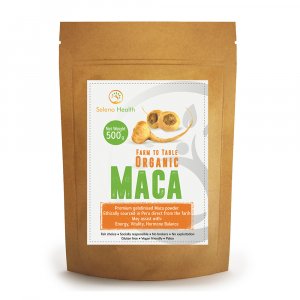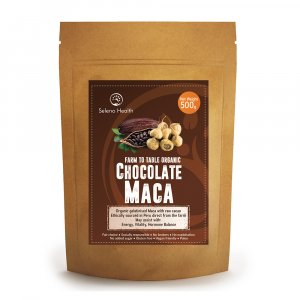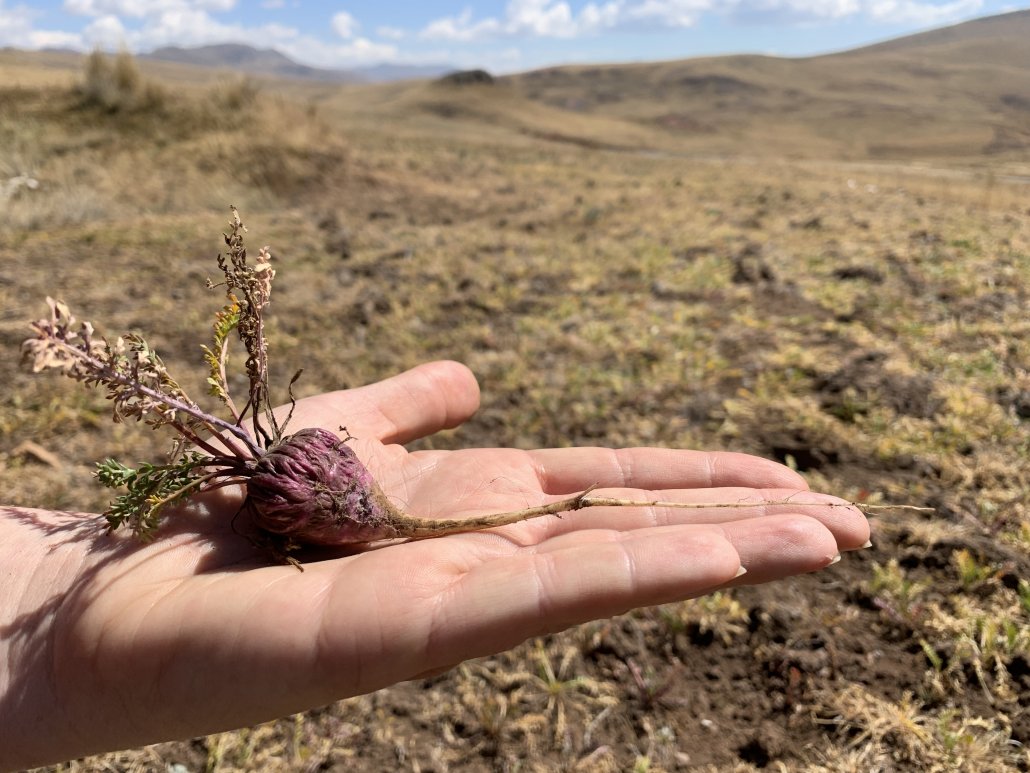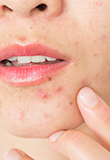How to treat metabolic syndrome with maca
Take 1-1.5 tsp per day of our Activated Yellow Maca or 2-3 tsp per day of our Activated Chocolate Maca for a min 6-12 weeks. For recipe ideas of how to include maca in your daily routine download our recipe booklet here or watch our recipe channel here.
Option 1
1-1.5 tsp daily
Maca for treating metabolic syndrome
Metabolic syndrome consists of several risk factors for heart disease and diabetes. Notably, the characteristics of this syndrome include elevated waist circumference, elevated fatty lipids in the blood, high blood pressure, high fasting glucose indicating minor insulin resistance, and reduced levels of “good” cholesterol. Since metabolic syndrome symptoms preclude more severe conditions, addressing these factors may reduce the risk of developing heart disease and diabetes.
Across the world, the prevalence of metabolic syndrome is rising, possibly due to the parallel increase in obesity and diabetes1. In the United States, 40% of men and 30% of women are overweight. Obesity rates are nearly as high, with 35% of men and 36% of women meeting the criteria for obesity2. Canada has a 10% lower prevalence of obese adults compared to the US1, demonstrating international differences in prevalence and criteria. Within countries, metabolic syndrome prevalence varies within population subgroups divided by race/ethnicity measured in the US1 and UK3. Metabolic syndrome doubles the risk of atherosclerosis and cardiovascular disease1,4.
Diagnosis and assessment with three of the five factors5
- Elevated waist circumference
- Elevated triglycerides
- Reduced high-density lipoproteins (HDL-C)
- Elevated blood pressure (hypertension)
- Elevated fasting glucose
Associated medical conditions6
- Cholesterol gallstones
- Obstructive sleep apnea
- Fatty liver
- Gout
- Depression
- Musculoskeletal disease
- Polycystic ovarian syndrome
Causal links6
- Obesity
- Physical inactivity
- Adipose tissue disorders
- Genetic and racial factors
- Ageing
- Endocrine disorders
Most patients with type 2 diabetes will have metabolic syndrome by the proposed criteria5. Waist circumference guidelines generally followed according to the international diabetes foundation, although there are different thresholds for population subgroups which can be divided into nationality and race/ethnicity1,5.
The fundamental component of metabolic syndrome treatment consists of eating a healthier diet, increased physical activity and weight loss. Maca is a traditional medicinal root grown in the Andes mountains at high altitude and has several properties to counter metabolic syndrome. It is traditionally used to improve energy and vitality and ensure longevity in life.
How maca can assist those with metabolic syndrome
To bolster a healthier diet, maca provides7,8,9:
- Alkaloids
- 5 important amino acids
- A cocktail of phytosterols and flavonoids
- 6 Minerals
- 5 Vitamins
- Macaenes (good fatty acids)
- Macamides (good fatty acids)
In laboratory and clinical studies, maca combated elevated triglycerides and increased low levels of good cholesterol (HDL). In post-ovariectomised rats, maca prevented cholesterol and HDL levels from increasing and maintained them at an ongoing healthy level10. In a human clinical pilot study, maca treatment increased HDL levels (our good cholesterol), thereby improving metabolic function and reducing risk of heart disease11.
In addition to changing blood lipid profile, maca addresses the typical feature of metabolic syndrome – elevated waist circumference. In a study comparing maca treatment periods, male rats exhibited weight loss after short-term administration of maca, whereas female rats taking maca showed an effect over long term treatment12. In a human clinical pilot study, maca treatment reduced body weight11. The mechanism behind these results may be, in part, due to the chemical composition of maca. Fatty acid amide hydrolase (FAAH) activity positively correlates with body mass index (BMI)13. Maca contains high amounts of macamides, which directly inhibit FAAH in a concentration and time-dependent manner 14,15,16. The presence of N-alkylamides within maca root also contributes to FAAH inhibition17. These molecular components in maca have the potential to reduce BMI and weight.
For those with diabetes maca has been shown in animal studies to significantly improve glucose tolerance as well as liver function by increasing production and activity of glutathione and glutathione peroxidase18. Maca combats fatigue, a symptom of metabolic syndrome19,20,21,22, and likely a key player in reducing the motivation for physical activity. See our article on the anti-fatigue effects of maca in our previous blog article. Maca has some unique molecular properties to alter brain biochemistry as a potential target for anti-fatigue effects. By inhibiting FAAH, maca increases available anandamide (AEA) in neurons and the synapse. AEA is the primary endocannabinoid agonist for cannabinoid receptor 1 (CB1R)23. In correlation with the molecular evidence, maca positively affects mood in women post-menopause or experiencing sexual dysfunction24,25. Elevated mood may increase the likelihood of physical activity by decreasing stress.
Further evidence identifies maca as a potential treatment for the reduction in blood pressure, a hallmark for increased risk of cardiovascular disease. In post-menopausal women, maca treatment reduced blood pressure26. In a human clinical pilot study, maca treatment reduced blood pressure11. These studies provide evidence for maca to treat metabolic syndrome in humans and furthermore no known contraindications prohibit it’s use with medication related to metabolic syndrome.
Customer testimonials with metabolic syndrome
Given me a new lease of life
I was so glad i found The Maca Experts as they really seemed to know their stuff. They advised me on what to take and after combining maca for men with some of the red extracts i had big improvements in energy, clarity and vitality. I felt able to be more active and have since lost 15kg. My blood pressure has come down and my libido has gone up. Ive also seen improvements in my prostate with the red sachets, can sleep through the night easily now without needing to get up to urinate. Wow this stuff really works.

Recovery from stroke and migraine
I took the concentrated black maca for my stroke symptoms including speech impediment, vertigo, headaches, migraines and co-ordination loss. Within 6 weeks i noticed a marked improvement in my speech and felt my brain was clearer than ever before. I haven't had a migraine since and any episodes of vertigo. Im really impressed with how well it worked to help me in my recovery.

THIS MACA POWDER HAS TOTALLY CHANGED MY LIFE
This powder has totally changed my life! It helped me get off antidepressants, balanced my hormones, helps hugely with anxiety & depression, I’m living free, but it is about the holistic approach.

Note: There is no upper limit with maca and everybody is different, so it is important to find your ideal dose that is right for your body, for some this may be less than the recommended for others it may be more. If you experience positive health benefits then we suggest you continue treatment at that ideal dosage. The material provided on this website is for information purposes only. It is not intended to replace medical advice or be a treatment for any medical condition. Users should consult a health professional if you have any concerns about your health, are starting any health or nutritional related treatment, or for any questions you may have regarding your own or any other party’s medical condition. Information and statements regarding dietary supplements have not been evaluated by the Food and Drug Administration and are not intended to diagnose, treat, cure, or prevent any disease.
Bibliography
- Grundy, S. M. (2008). Metabolic syndrome pandemic. Arteriosclerosis, thrombosis, and vascular biology, 28(4), 629-636.
- Yang, L. and Colditz, G.A., 2015. Prevalence of overweight and obesity in the United States, 2007-2012. JAMA internal medicine, 175(8), pp.1412-1413.
- Tillin, T., Forouhi, N., Johnston, D. G., McKeigue, P. M., Chaturvedi, N., & Godsland, I. F. (2005). Metabolic syndrome and coronary heart disease in South Asians, African-Caribbeans and white Europeans: a UK population-based cross-sectional study. Diabetologia, 48(4), 649-656.
- Després, J. P., Lemieux, I., & Alméras, N. (2006). Abdominal Obesity and the Metabolic Syndrome. Overweight and the Metabolic Syndrome, 137-152.
- Alberti, K.G.M.M., Eckel, R.H., Grundy, S.M., Zimmet, P.Z., Cleeman, J.I., Donato, K.A., Fruchart, J.C., James, W.P.T., Loria, C.M. and Smith Jr, S.C., 2009. Harmonizing the metabolic syndrome: a joint interim statement of the international diabetes federation task force on epidemiology and prevention; national heart, lung, and blood institute; American heart association; world heart federation; international atherosclerosis society; and international association for the study of obesity. Circulation, 120(16), pp.1640-1645.
- Grundy SM, Cleeman JI, Daniels SR, Donato KA, Eckel RH, Franklin BA, Gordon DJ, Krauss RM, Savage PJ, Smith SC Jr., Spertus JA, Costa F. American Heart Association; National Heart, Lung, and Blood Institute. Diagnosis and management of the metabolic syndrome: an American Heart Association/National Heart, Lung, and Blood Institute Scientific Statement. Circulation. 2005; 112: 2735–2752.
- Muhammad, I., et al., Constituents of Lepidium meyenii ‘maca’. Phytochemistry, 2002. 59(1): p. 105-10.
- McCollom, M.M., et al., Analysis of macamides in samples of Maca (Lepidium meyenii) by HPLC-UV-MS/MS. Phytochem Anal, 2005. 16(6): p. 463-9. https://www.ncbi.nlm.nih.gov/pubmed/16315492
- Zhao, J., et al., New alkamides from maca (Lepidium meyenii). J Agric Food Chem, 2005. 53(3): p. 690-3. https://www.ncbi.nlm.nih.gov/pubmed/15686421
- Meissner HO, Mrozikiewicz P, Bobkiewicz-Kozlowska T, et al. Hormone-Balancing Effect of Pre-Gelatinized Organic Maca (Lepidium peruvianum Chacon): (I) Biochemical and Pharmacodynamic Study on Maca using Clinical Laboratory Model on Ovariectomized Rats. Int J Biomed Sci. September 2006;2(3):260–272.
- Meissner, H. O., Reich-Bilinska, H., Mscisz, A., & Kedzia, B. (2006). Therapeutic Effects of Pre-Gelatinized Maca (Lepidium peruvianum Chacon) used as a non-hormonal alternative to HRT in perimenopausal women-Clinical Pilot Study. International journal of biomedical science: IJBS, 2(2), 143. https://www.ncbi.nlm.nih.gov/pmc/articles/PMC3614596/
- Meissner, H. O., Kedzia, B., Mrozikiewicz, P. M., & Mscisz, A. (2006). Short and long-term physiological responses of male and female rats to two dietary levels of pre-gelatinized Maca (Lepidium Peruvianum Chacon). International journal of biomedical science: IJBS, 2(1), 13. https://www.ncbi.nlm.nih.gov/pmc/articles/PMC3614567/
- Cable, J. C., Tan, G. D., Alexander, S. P., & O’Sullivan, S. E. (2011). The activity of the endocannabinoid metabolising enzyme fatty acid amide hydrolase in subcutaneous adipocytes correlates with BMI in metabolically healthy humans. Lipids in health and disease, 10(1), 129. https://www.ncbi.nlm.nih.gov/pubmed/21813022
- Almukadi, H., Wu, H., Böhlke, M., Kelley, C. J., Maher, T. J., & Pino-Figueroa, A. (2013). The macamide N-3-methoxybenzyl-linoleamide is a time-dependent fatty acid amide hydrolase (FAAH) inhibitor. Molecular neurobiology, 48(2), 333-339. https://www.ncbi.nlm.nih.gov/pubmed/23853040
- Alasmari, M., Bӧhlke, M., Kelley, C., Maher, T., & Pino-Figueroa, A. (2019). Inhibition of Fatty Acid Amide Hydrolase (FAAH) by Macamides. Molecular neurobiology, 56(3), 1770-1781. https://www.ncbi.nlm.nih.gov/pubmed/24972328
- Wu, H., Kelley, C. J., Pino-Figueroa, A., Vu, H. D., & Maher, T. J. (2013). Macamides and their synthetic analogs: evaluation of in vitro FAAH inhibition. Bioorganic & medicinal chemistry, 21(17), 5188-5197. https://www.ncbi.nlm.nih.gov/pubmed/23891163
- Hajdu, Z., Nicolussi, S., Rau, M., Lorántfy, L., Forgo, P., Hohmann, J., Csupor, D. and Gertsch, J., 2014. Identification of endocannabinoid system-modulating N-alkylamides from Heliopsis helianthoides var. scabra and Lepidium meyenii. Journal of natural products, 77(7), pp.1663-1669. https://www.ncbi.nlm.nih.gov/pubmed/29926378
- Vecera R. et al. The influence of maca (Lepidium meyenii) on antioxidant status, lipid and glucose metabolism in rat. Plant Foods Hum Nutr. 2007 Jun;62(2):59-63.
https://www.ncbi.nlm.nih.gov/pubmed/17333395 - Shin, S., et al., Gelatinized and fermented powders of Lepidium meyenii (Maca) improve physical stamina and epididymal sperm counts in male mice. J. Emb. Trans, 2008. 23: p. 283-289. https://www.researchgate.net/publication/291889082_Gelatinized_and_fermented_powders_of_Lepidium_meyenii_Maca_improve_physical_stamina_and_epididymal_sperm_counts_in_male_mice
- Choi, E.H., et al., Supplementation of standardised lipid-soluble extract from maca (Lepidium meyenii) increases swimming endurance capacity in rats. Journal of Functional Foods, 2012. 4(2): p. 568-573. http://www.sciencedirect.com/science/article/pii/S1756464612000436
- Tang, W., Jin, L., Xie, L., Huang, J., Wang, N., Chu, B., … & Zhang, Y. (2017). Structural characterization and antifatigue effect in vivo of maca (Lepidium meyenii Walp) polysaccharide. Journal of food science, 82(3), 757-764. https://www.ncbi.nlm.nih.gov/pubmed/28231388
- Li, J., Sun, Q., Meng, Q., Wang, L., Xiong, W., & Zhang, L. (2017). Anti-fatigue activity of polysaccharide fractions from Lepidium meyenii Walp.(maca). International journal of biological macromolecules, 95, 1305-1311. https://www.ncbi.nlm.nih.gov/pubmed/27840217
- Zou, S., & Kumar, U. (2018). Cannabinoid receptors and the endocannabinoid system: signaling and function in the central nervous system. International journal of molecular sciences, 19(3), 833. https://www.ncbi.nlm.nih.gov/pubmed/29533978
- Rubio, J., Caldas, M., Dávila, S., Gasco, M., & Gonzales, G. F. (2006). Effect of three different cultivars of Lepidium meyenii (Maca) on learning and depression in ovariectomized mice. BMC complementary and alternative medicine, 6(1), 23.
- Dording, C. M., Schettler, P. J., Dalton, E. D., Parkin, S. R., Walker, R. S., Fehling, K. B., … & Mischoulon, D. (2015). A double-blind placebo-controlled trial of maca root as treatment for antidepressant-induced sexual dysfunction in women. Evidence-Based Complementary and Alternative Medicine, 2015.
- Stojanovska, L., Law, C., Lai, B., Chung, T., Nelson, K., Day, S., Apostolopoulos, V. and Haines, C., 2015. Maca reduces blood pressure and depression, in a pilot study in postmenopausal women. Climacteric, 18(1), pp.69-78.




















Leave a Reply
Want to join the discussion?Feel free to contribute!